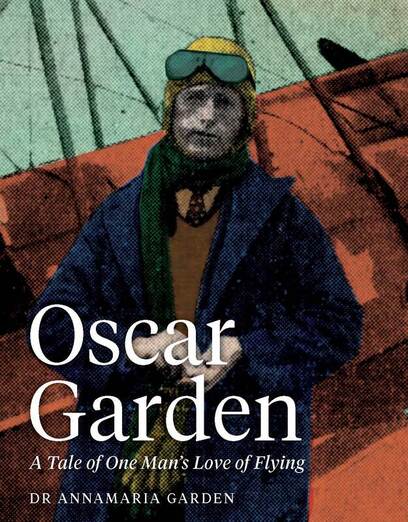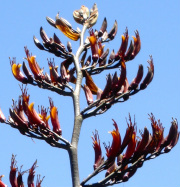
by Dr Annamaria Garden
One day a young man walked into Selfridges store in London and bought an aeroplane. He then proceeded to learn to fly and having accumulated the vast total of 12 hours and 55 minutes of dual instruction, decided to gain the necessary 100 hours of solo flying, for his commercial licence, by piloting his own aircraft to Australia.
This man was the author’s father Oscar Garden and the book recounts the history of a very early pioneer of aviation.
Oscar was born in Scotland but his parents split up when he was 11, his father moving to Timaru where he opened an aerated water factory. Oscar remained in the United Kingdom with his mother, but she found it very hard to cope financially, and so they both moved to New Zealand in 1920. He was 17 years old. Oscar accumulated some capital from rabbiting and opened a cycle repair shop and later a garage in Southbridge, which he operated for two years, and then moved to Sydney for a while. Finally, with a thousand pounds in his pocket, he sailed to England and there became interested in flying, an interest that shaped the next few years of his life.
The aircraft he bought was a blue Gypsy Moth on which he had painted the name Kia Ora in silver on the fuselage.
His plan was to fly it to New Zealand and obtained sponsorship from the Vacuum Oil company, who arranged fuel depots along the route for him. He took off with no publicity, no crowd seeing him off and flew the first leg to Munich, then through the Balkans to Syria, Iraq and Iran. Then followed Karachi, Calcutta, Rangoon and Singapore, finally to Australia.
The author has access to his logbooks and gives a daily account of the flight based on these. Although some further details have been provided by others, I am sure much more drama and excitement took place than is told in the logbook. Oscar’s attention to detail and his lack of fuss shows through the story of his flight and this is evident throughout his life. He expected no great welcome anywhere, so the accolades that were awarded to him on his arrival in Australia astounded him. He received civic welcomes and was feted by aero clubs at every city he touched down in.
The Gypsy Moth did not have the range to fly to New Zealand, so he and the aircraft were shipped across the Tasman. In New Zealand he undertook tours of both the North and South Islands, arranged by his sponsor Vacuum Oil Ltd, under the name of their petrol brand Plume. He visited almost every corner of the country, from the Far North to Stewart Island where he was the first pilot to land.
A period of barnstorming in South Africa followed, but did not produce the financial rewards hoped for. Oscar then went back to England to complete his pilot training, and became a career airline pilot, starting with United Airways, one of several companies that merged to form British Airways. In 1938 he joined Imperial Airways with the goal of gaining experience in flying boats, because he had the dream of flying a service across the Tasman.
He realised his dream when in April 1940, despite the difficulties of the war, the service between Rose Bay in Sydney and Mechanic’s Bay in Auckland began, Oscar being commanding pilot of the second flight.
The two aircraft, Awatere and Aotearoa, had many adventures, mainly involving the weather, but as they gathered experience they began to lower the trans-Tasman flight times by significant amounts. There was no long range weather forecasting, the planes were not pressurised and the cabins were not adequately heated, so the captain would ask the passengers, “do you want to stay low and suffer airsickness, or shall we climb higher where it’s smoother but colder”. They generally agreed that they could put up with a little cold in exchange for smoothness.
Oscar became operations manager for TEAL, but they parted company because of a disagreement over the aircraft chosen to replace the flying boats. He wanted pressurised, land based aircraft, but the management bowed to political pressure and insisted on buying British made Solent flying boats, over American land based aircraft. He then became a horticulturist running a successful tomato farm near Tauranga, until his death at age 93.
I found this book really interesting, as it tells the life story of the almost unnoticed of New Zealand’s aviation pioneers. Sometimes I would have liked more details of various incidents in his flying exploits, and sometimes the accounts of the various civic receptions became a little repetitive, but overall it’s a good read and I can recommend it.
Author: Dr Annamaria Garden
Publisher: Mary Egan Publishing
ISBN: 9780473516536
RRP: $45
Available: bookshops

 RSS Feed
RSS Feed
